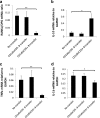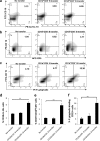B10 Cells Alleviate Periodontal Bone Loss in Experimental Periodontitis
- PMID: 28652308
- PMCID: PMC5563573
- DOI: 10.1128/IAI.00335-17
B10 Cells Alleviate Periodontal Bone Loss in Experimental Periodontitis
Abstract
B10 cells can regulate inflammatory responses in innate immunity. Toll-like receptors (TLRs) play an important role in B cell-mediated immune responses in periodontal disease. This study aimed to determine the effects of TLR-activated B10 cells on periodontal bone loss in experimental periodontitis. Spleen B cells isolated from C57BL/6J mice were cultured with Porphyromonas gingivalis lipopolysaccharide (LPS) and cytosine-phospho-guanine (CpG) oligodeoxynucleotides for 48 h. B10-enriched CD1dhi CD5+ B cells were sorted by flow cytometry and were adoptively transferred to recipient mice through tail vein injection. At the same time, P. gingivalis-soaked ligatures were placed subgingivally around the maxillary second molars and remained there for 2 weeks before the mice were euthanized. Interleukin-10 (IL-10) production and the percentage of CD1dhi CD5+ B cells were significantly increased with treatment with P. gingivalis LPS plus CpG compared to those in mice treated with P. gingivalis LPS or CpG alone. Mice with CD1dhi CD5+ B cell transfer demonstrated reduced periodontal bone loss compared to the no-transfer group and the group with CD1dlo CD5- B cell transfer. Gingival IL-10 mRNA expression was significantly increased, whereas expressions of receptor activator of NF-κB ligand (RANKL)/osteoprotegerin (OPG), tumor necrosis factor alpha (TNF-α), and IL-1β were significantly inhibited in the CD1dhi CD5+ B cell transfer group. The percentages of CD19+ IL-10+ cells, CD19+ CD1dhi CD5+ cells, and P. gingivalis-binding CD19+ cells were significantly higher in recovered mononuclear cells from gingival tissues of the CD1dhi CD5+ B cell transfer group than in tissues of the no-transfer group and the CD1dlo CD5- B cell transfer group. This study indicated that the adoptive transfer of B10 cells alleviated periodontal inflammation and bone loss in experimental periodontitis in mice.
Keywords: B cell; CpG; LPS; Toll-like receptor; lipopolysaccharide; periodontitis.
Copyright © 2017 American Society for Microbiology.
Figures





Similar articles
-
Local promotion of B10 function alleviates experimental periodontitis bone loss through antagonizing RANKL-expressing neutrophils.J Periodontol. 2021 Jun;92(6):907-920. doi: 10.1002/JPER.20-0074. Epub 2020 Sep 20. J Periodontol. 2021. PMID: 32845513
-
Local Induction of B Cell Interleukin-10 Competency Alleviates Inflammation and Bone Loss in Ligature-Induced Experimental Periodontitis in Mice.Infect Immun. 2016 Dec 29;85(1):e00645-16. doi: 10.1128/IAI.00645-16. Print 2017 Jan. Infect Immun. 2016. PMID: 27795360 Free PMC article.
-
TLR4 supports the expansion of FasL+CD5+CD1dhi regulatory B cells, which decreases in contact hypersensitivity.Mol Immunol. 2017 Jul;87:188-199. doi: 10.1016/j.molimm.2017.04.016. Epub 2017 May 12. Mol Immunol. 2017. PMID: 28505514
-
Immune response: the key to bone resorption in periodontal disease.J Periodontol. 2005 Nov;76(11 Suppl):2033-41. doi: 10.1902/jop.2005.76.11-S.2033. J Periodontol. 2005. PMID: 16277573 Review.
-
Toll-Like Receptor Signaling and Immune Regulatory Lymphocytes in Periodontal Disease.Int J Mol Sci. 2020 May 8;21(9):3329. doi: 10.3390/ijms21093329. Int J Mol Sci. 2020. PMID: 32397173 Free PMC article. Review.
Cited by
-
IL-10 Dampens an IL-17-Mediated Periodontitis-Associated Inflammatory Network.J Immunol. 2020 Apr 15;204(8):2177-2191. doi: 10.4049/jimmunol.1900532. Epub 2020 Mar 13. J Immunol. 2020. PMID: 32169848 Free PMC article.
-
Microhardness Measurements on Tooth and Alveolar Bone in Rodent Oral Disease Models.J Vis Exp. 2024 Apr 26;(206):10.3791/66583. doi: 10.3791/66583. J Vis Exp. 2024. PMID: 38738893 Free PMC article.
-
CD19+ CD24hi CD38hi Regulatory B Cells and Memory B Cells in Periodontitis: Association with Pro-Inflammatory and Anti-Inflammatory Cytokines.Vaccines (Basel). 2020 Jun 26;8(2):340. doi: 10.3390/vaccines8020340. Vaccines (Basel). 2020. PMID: 32604936 Free PMC article.
-
Peripheral blood immune cell levels differ with the stage and grade of periodontitis in systemically healthy individuals.Clin Oral Investig. 2025 Feb 8;29(2):125. doi: 10.1007/s00784-025-06210-x. Clin Oral Investig. 2025. PMID: 39921746
-
From Crosstalk between Immune and Bone Cells to Bone Erosion in Infection.Int J Mol Sci. 2019 Oct 17;20(20):5154. doi: 10.3390/ijms20205154. Int J Mol Sci. 2019. PMID: 31627424 Free PMC article. Review.
References
-
- Garlet GP, Cardoso CR, Silva TA, Ferreira BR, Avila-Campos MJ, Cunha FQ, Silva JS. 2006. Cytokine pattern determines the progression of experimental periodontal disease induced by Actinobacillus actinomycetemcomitans through the modulation of MMPs, RANKL, and their physiological inhibitors. Oral Microbiol Immunol 21:12–20. doi:10.1111/j.1399-302X.2005.00245.x. - DOI - PubMed
Publication types
MeSH terms
Grants and funding
LinkOut - more resources
Full Text Sources
Other Literature Sources

